After a month in Thailand, it was time for us to move on–it had been a wonderful experience–great beaches, killer rock climbing, awesome food, and just the vast variety of people and activities–yet, we both felt that we had absorbed the essence of this country and found ourselves ready to move along.
On the other hand, Cambodia–for me anyway–offered no expectations. Sarah had really wanted to visit Angkor Wat, while her hick husband from One Horse, Washington, US of A had barely even heard of it. I have been reading about it, though, and also about the horrible era of the Khmer Rouge back in the 1970’s; this, along with the glowing praise we’ve heard from fellow travellers has left me intrigued as we prepare to enter Cambodia.
We were not looking forward to crossing the border, though; the one that is easiest to reach from Bangkok (I can’t remember if Sarah wrote about returning to the capital in her last blog, but we spent one final day there–just more of “same-same”) is also the most corrupt, and my ongoing personal war with the entire region’s tuk-tuk drivers promised to escalate with the many scams they are known to operate within the last 6 km of Thailand. We lucked out, though, and accidentally booked a minibus that took us all the way to the border instead of dropping us off at the bus station, so all those devious, parasitic scam artists would just have to do without wasting our time and money.
Crossing the border was easy, but we did get ripped off on our visas by a few dollars because we paid in Thai Baht, and the exchange rate was bad. Anyway, we were just happy that the whole thing went quickly–there is nothing like stepping into the few hundred meters when you are officially in no-man’s land and wondering what will happen if the new country’s security dislikes the cut of your gib!
There is a local bus station in Poipet (a town referred to affectionately by Lonely Planet as “the armpit of Cambodia”), but it is much easier to use the tourist shuttle that takes you to the tourist station; I think you end up paying a bit more for transport to Siem Riep, but it’s not bad, and they also drive you to the hotel that you want without any hastles. While trying to board the shuttle, we also had one of the funnier moments of our trip when a large group of Russians commandeered an entire bus even though they left it only half full; every time someone tried to get on the bus, this tall, skinny dude would rush to block the door with hands extended in “talk to the wall” position and growl, “NO–Not Russian!!” at the confused traveller. I wondered if he had told the others that he had booked a VIP bus for them or something; I also wondered why the entire group of them were wearing fedoras.
Our hotel was called “Mandalay Inn,” so I had to resist the urge to burst out of our bathroom with my pants around my ankles screaming, “Say Mandalay Industries, Say Mandalay Industries”! Eventually, I was able to ignore the urge that most of us secretly harbor to emulate George Castanza, and turned in for a good night’s sleep after a long day of travel.
Most people hire a moto (another type of tuk-tuk) for the day when visiting Angkor Wat, and Siem Riep has about 10,000 of them offering their services, although they are much more laid back than in other places. We wanted to do it on our own, though, so we rented a couple of bikes for a dollar each and set off to explore the ancient ruins from the saddles of our bikes!
Angkor Wat is about six kilometers outside of Siem Riep, so we had a nice little ride out there; while the city’s traffic is not particularly bad, there are no regulated intersections, so you just sort of try not to collide with anyone. The motorbikes’ curious habit of riding the wrong way down streets in lieu of making left turns spiced things up as well. Once out of the city, however, the landscape and traffic shifted surprisingly quickly to being rural and relatively quiet.
You can see Angkor Wat from a good distance away; the conical towers and castle-like build surrounded by the moat makes for a lasting first impression. The main tower was supposed to represent mythical Mt. Meru, with surrounding smaller towers being lesser peaks, the courtyards symbolizing the continents, and the moat being the ocean. It was built sometime during the first half of the 10th century by a King with a really long name the second (Suryvarman II, for thsse keeping score), during the time when the Khmer Empire (Cambodia) also ate up most of present-day Laos and Vietnam, as well as a good chunk of Eastern Thailand.
We began by checking out the bas-reliefs around the outer square of the main temple; one of our first impressions was that despite being older than some of the ancient monuments that we had seen in India and Kathmandu, Angkor has been much better maintained and remains in much better shape. Having once been a Hindu temple, the bas-reliefs focus on scenes from the Indian Ramayana: a great battle in which soldiers fought from the saddles of their elephants, and my favorite, “The Churning of the Ocean of Milk,” in which guardians and demons appear to being playing an epic game of tug’o’war using a giant serpent–the two sides are really creating an elixir of immortality. I didn’t fully understand the exact mechanics of the churning operation, but it looked cool.
Next, we climbed the tower by ascending a very steep staircase; the views of the surrounding area were excellent, and I was surprised to find that the view outward was just as good as the views of the wat from the road. From here, you could see just how large the largest religious structure in the world really is, and it was a wonder to imagine the wat teeming with life over 1,000 years ago. The wat is still in use, a place of pilgrimmage for many, but Buddhas replaced the Hindu idols (mainly Vishnu) long ago as the Khmers switched faiths. Overall, Angkor has a strange ability to charm a person increasingly as he/she moves toward its heart; I am not exactly sure why, but maybe that is what gives it its staying power as one of the world’s most intriguing relics.
After grabbing some lunch from one of the gazillion noodle stalls across the road, we hopped on the bikes to continue our tour. We briefly rode through the ancient city of Angkor Thom, our destination for tomorrow, before leaving the city’s walls to explore some of the lesser known temples. Our path is known as the “Grand Circuit,” which proved to be an apt name for our ambitious agenda; I think we ended up putting in around 20 miles on our klunky old one-speeds by the day’s end. We simply admired a few of the temples from the road, but we stopped at a few, including Preah Kahn–once the home of more than 1,000 teachers–and Preah Neak Pean, which had a lovely setting among pools that I think were actually man-made works of old.
While it may not be officially on the Unesco World Heritage Site map just yet, Swenson’s Ice Cream Shop probably should be, and it was the perfect stop after our long day’s bicycle journey. I could describe the ice cream for you, but instead I’ll just leave it to the expert’s photo below.
The food for the most part in Cambodia is similar to the food that was available in Thailand, although not as spicy, but we did have a very interesting dinner of Khmer specialties that night. Among the dishes we enjoyed were lettuce-wrapped spring rolls, green mango salad, green chicken curry, pork ribs, and the national dish–fish amok, chunks of flaky white fish baked in banana leaves. The sampler was a nice taste of a good range of dishes and also included bananas in warm coconut milk for dessert. Delicious!
We covered less ground but no fewer temples on our second day in Angkor. Once again, we managed to avoid unavoidable death as we pedaled out of town, past Angkor Wat, and on to the ruins of Angkor Thom, the ancient city that once held nearly a million people within the walls of its 10 square kilometers. Under the rules of religion, humans were only allowed to build houses or other human structures of wood, so only the stone buildings used for religious purposes remain.
All of Angkor’s sites are governed by the rules of symmetry, and the gates on each side of the city are no different. Leading up to each gate are 54 statues on either side, recreating the “Sea of Milk” scene, and faces of the The God of Compassion emerge from the top of each gate.
The main point of interest is the Bayon, a huge temple with 54 Gothic towers. Probably the second-most famous image of Angkor, these towers all feature the face of Avalokiteshvara (the same God of Compassion as on the gates), but the popular belief is that that faces also look very much like the Khmer ruler who had Angkor Thom built. What better way to remind your subjects that you are all-powerful (uh…I mean, compassionate) than to literally have your eyes everywhere? It was a very interesting place.
Nearby the Bayon, we visited a huge tower that has an interesting story. Archeologists had completely taken it apart before Cambodia’s Civil War in the 1970’s, but the Khmer Rouge–who tried to destroy anything of religious or intellectual content–destroyed all of the records and instructions for rebuilding it. It has taken nearly 40 years of research and reconstruction to put it back together again (Humpty Dumpty ain’t nothin’), and many piles of this jigsaw still sit on the ground in various stages of completion.
Before leaving Angkor Thom, we walked along the 350 meter Elephant Terrace and the Terrace of the Leper King; the former would have been used for important public ceremonies and the latter may have been a crematory site. Giant elephant carvings give the first terrace an impression of a grand parade.
After lunch, we visited two more temples before heading back. The first, Ta Prohm, looks like something out of an Indiana Jones movie; huge trees have wrapped themselves around the ruins of this temple, as if nature has decided to reclaim the rock used to build the structure. It was a really neat place, and I was not surprised to find out that it had been used in a couple of Hollywood films. Ta Prohm probably looks much like the other temples of Angkor when they began to be rediscovered several hundred years ago.Â
The last temple we visited, Phnom Bakheng, was not of major noteworthy difference from most other temples in Angkor, other than its location up on a hill, which offers a very nice view of Angkor from above. Many people like to watch the sunset from up there, but we were far too early and had no desire to sit up there in the baking sun.
Our trip back home was delayed, however, by a flat tire on Sarah’s bike. Luckily, Angkor Wat was only about a quarter of a mile away, and there was a tire repair stand across the way. It even ended up being sort of fun, as we got to watch a dude who, from the looks of his can collection, had to have been pretty lit on Angkor beer fix the tire using the same process as we use but with mammoth hand tools. There was even a free fruit tasting included; a woman had just delivered this sort of plum thing that had a sweet, milky pulp center, and the guy shared one with us. Also, a rooster that decided that I was trying to steal his women kept threatening me with some sort of war dance, but I stood my ground. Anyway, 15 minutes later, we left the wonders of Angkor Wat behind and embarked on the arduous journey back to Siem Riep and the wonderful land of Swenson’s ice cream!

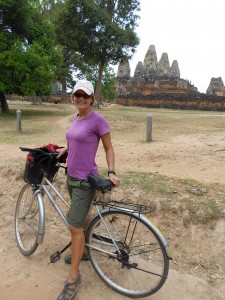
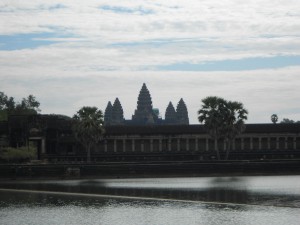

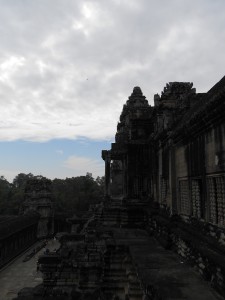

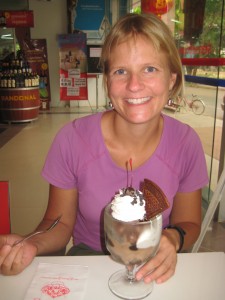
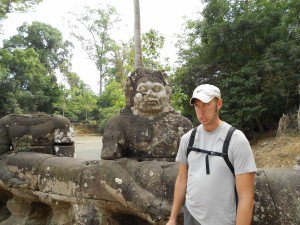
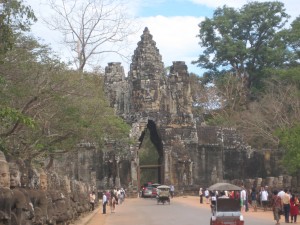
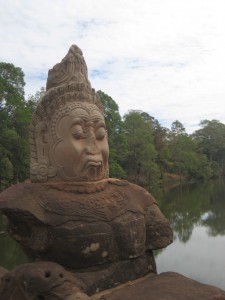


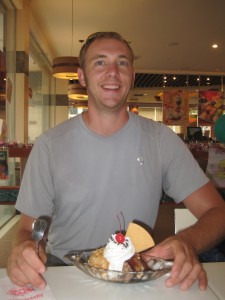
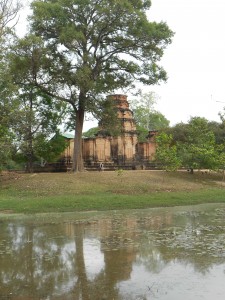
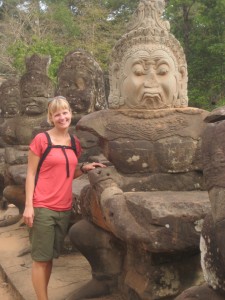
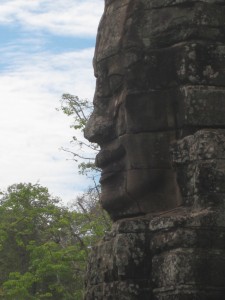
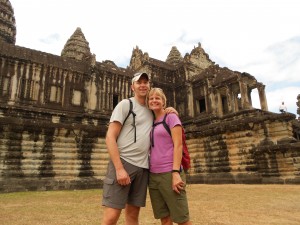
Very cool, and one of the most famous places on earth. From your report it wasn’t a disappointment either. I thought it very cool that you rode bikes, nostalgic to the max. Also, Mike’s expressions were great.
Suryvarman II!
Yes!!
So glad you guys are having a great time! Thanks for letting me live vicariously though you from my office chair 🙂
We want to visit you on our way home! Thanks for following us.
Your trip is still sounding awesome. Happy travels!
Thanks, we miss you and Jared!
Vandalay industries, how can I help you?!?!?!!
Of course, I love the bike-ride portion of your adventure.
I’ll never forget the day the three of us rode together and I got four (4!!) flat tires but the SAG guy cheered us up with a floor pump and baggies of gummy bears. Sounds almost as good as your “fruit-tasting” with the drunk repair guy.
Hi Maria! We talked about that same day when we were getting my flat repaired! I could have used some gummy bears, but settled for ice cream later:)